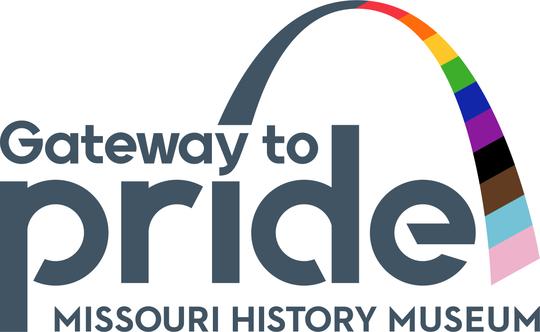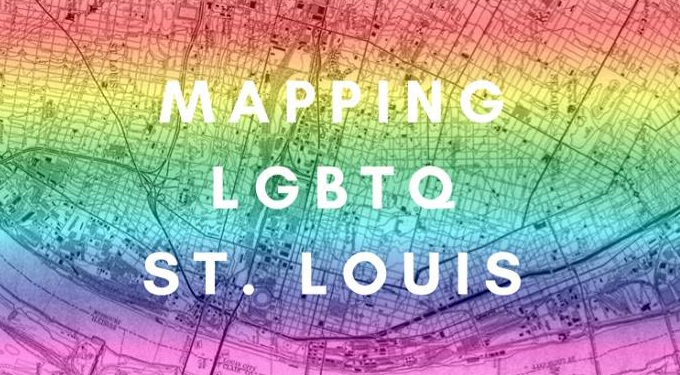Fall 2018 Calendar
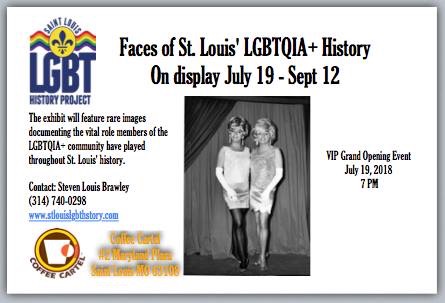
Posted September 3, 2018
Coffee Cartel Exhibit
Faces of St. Louis' LGBTQIA+ History
Through September 12, 2 Maryland Plaza
The Project offers an exhibit of rare images at Coffee Cartel.
St. Louis County Library Bridgeton Presentation
Monday October 1, 2018, 7 pm, Bridgeton Trails Branch
Join author Steven Louis Brawley, a historian specializing in LGBTQIA+ topics and founder of the St. Louis LGBT History Project, as he discusses St. Louis's rich LGBTQIA+ history. Learn about the LGBTQ+ community's countless struggles and successes since 1764, including protests, arrests, murders, celebrations and parades. Free. Registration required.
Missouri History Museum Presentation
Finding Lost Histories in the Modern LGBTQIA+ Alphabet
Wednesday, October 24, 7 pm, Lee Auditorium
Contemporary language descibing the LGBTQIA+ community is a relatively recent development, and it creates a challenge for historical research. Panelists will explore the roadblocks to researching LGBTQIA+ history and offer insights into uncovering lost histories. Free.
Project Research Suggests Bonnie Blake is the World's Oldest Performing Drag Queen
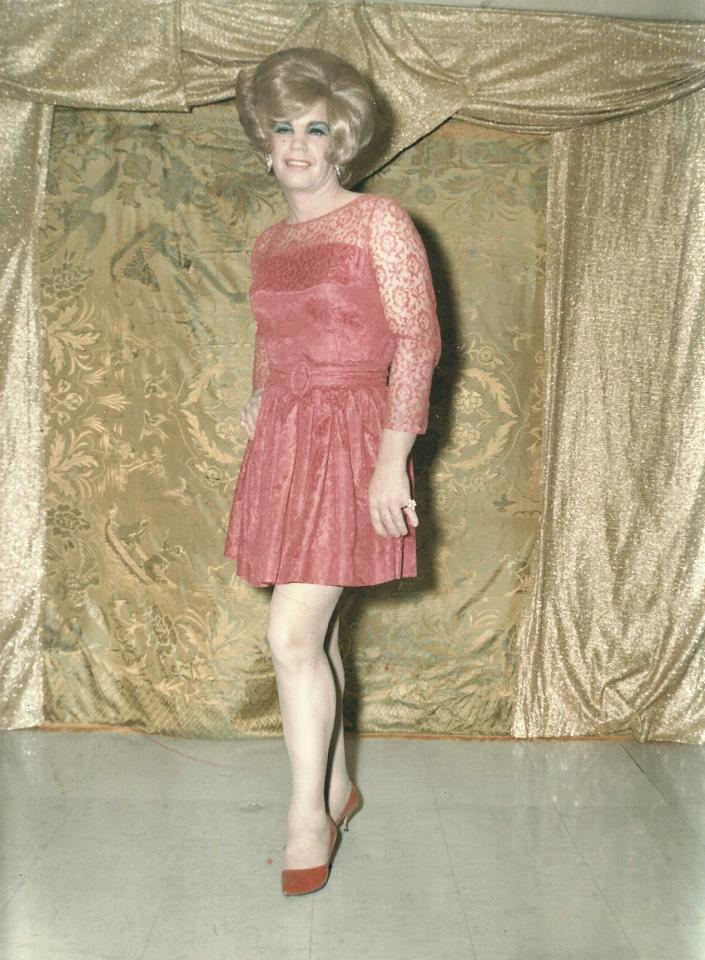 By Steven Louis Brawley
By Steven Louis Brawley
August 18, 2018: The St. Louis LGBT Project has bestowed the title of “Oldest Performing Drag Queen in the World” to John Chaney, who has performed as Bonnie Blake in St. Louis since the late 1950s. Chaney turned 90 on August 18.
Chaney bests by two years the current Guinness Book of World Records’ “Oldest Performing Drag Queen” Walter Cole (Darcelle XV) of Portland Oregon, who was born in 1930 and did not begin performing until the age of 37. The Project is reviewing Guinness’ application process to formally nominate Chaney in this category.
Chaney remembers doing a show around 1959 at the Snake Pit bar in downtown St. Louis. He was a popular member of the local drag show circuit on the east side of the river in the 1960s and 1970s.
Chaney was part of the first set of drag performers at the French Market gay bar in Soulard in 1972.
Since the late 1950s, Chaney has helped pave the way to mainstream drag performances in area gay bars during eras where anti-masquerading laws were on the books in St. Louis.
It did not become legal to do drag in St. Louis until 1985, after the laws were challenged.
He has operated several former gay bars including the Gallery Lounge and Blake’s. Since the late 1960s, he has also been the proprietor of John’s Furniture and Antiques on South Broadway.
Chaney still performs with local drag queen and drag king legends and is known for his love of country music, most notably Loretta Lynn.
Photo courtesy John Chaney.
Summer 2018 Calendar
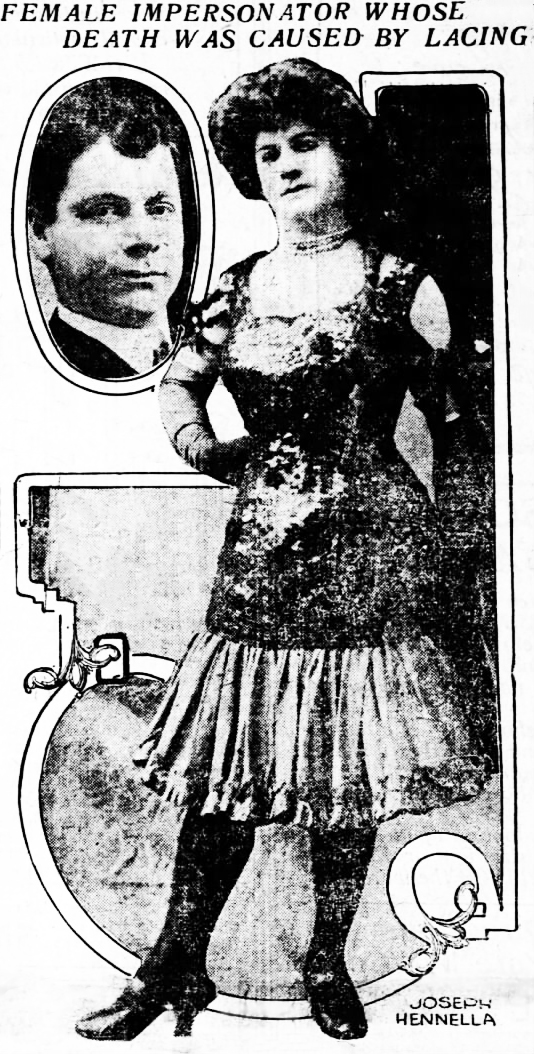 Missouri History Museum Presentation
Missouri History Museum Presentation
June 13, 7 pm, Lee Auditorium
Since the late 19th century, St. Louis audiences have been entertained by some of the world's foremost drag kings and queens. This was often a challenge since St. Louis' masquerading laws, which were on the books from the 1840s until 1985, prohibited a person from "appearing in public in a dress not belonging to his or her sex." Breaking this law landed many "impersonators" in jail. Steven Louis Brawley will be joined by legendary members of St. Louis' drag king and queen community to discuss the pivotal role these entertainers and social activists have played throughout St. Louis' history. Learn about the drag communities' legacy of competitive pageants, charitable causes, and political actions.
SAGE Lunch (SAGE Members)
June 20, 11:30 am, MCC
The Project will update our 2017 Transgender Spectrum Conference presentation on the complexity of researching transgender history.
PrideFest
June 23-24, Solider's Memorial
At this year's PrideFest History Village, the Project will offer an exhibit entitled "Headlines of Hate and Hope" documenting St. Louis' LGBTQIA+ experience via mainstream newspaper articles dating back to the mid-1800s. In addition to the exhibit, learn about other area groups and organizations that are making dramatic contributions to the research and preservation of our local LGBTQIA+ history.
Coffee Cartel Exhibit
July 19, 7 pm, 2 Maryland Plaza
The Project will offer an exhibit at Coffee Cartel from July 19 through September 12. Opening reception will be July 19, 7 pm.
Graphic: St. Louis Post-Dispatch, November 4, 1912
Growing Up Next to Tommy and Jane
 By Sharon Cortelyou
By Sharon Cortelyou
January 5, 2018: "Tommy" started walking the neighborhood when I was about twelve. Dressed in a tan trench coat, slacks and sensible shoes, she walked with purpose and did not meet my gaze when we met on the sidewalk. I had heard she had a heart attack and guessed that the walking was a suggestion from the doctor. Tommy and Jane were my next door neighbors for 18 years. In researching their lives, I found that they had bought the house on Sunset Blvd. in Cape Girardeau during the 1930s. My parents bought the house next door in the late 1950s and I was born a few years later. We lived there until my senior year in high school.
I am now very involved in collecting the history of the LGBT community and even for those born in the 40s, 50s, or 60s, I hear a common theme. Many say that they were adults before they even realized there was such a thing as a same sex relationship. It was a virtual unknown. But for me, that was not the case. Despite the conservative, small town, life of my childhood, I always knew there was such a thing. For better or worse, I had the "queers next door" which is how my father described them. I will point out that the label was not said with malice. My father seemed to like them much more than our neighbors on the other side. That was just the language he knew.
I never had much interaction with Tommy. I theorized that as the butch in the relationship, she might have been especially nervous about interacting with a young girl. I wonder if things would have been different if I were a boy. Jane, on the other hand, was friendly and always bought a box or two of Girl Scout cookies when I knocked on their door each year. They were quiet neighbors and rarely ever spent any time outside. They hired me to clean their fence line each year which generally left me covered with poison oak. Jane was born in 1908 so when I was nine, they were probably moving into their 60th year. I don't know if Tommy was older or younger. One thing I remember noticing about them is that every Sunday when we left for church, their car didn't move.
I never consciously connected who I was to who they were until after I came out at age 19. By then, we had just moved to another part of Cape Girardeau. But one very vivid memory was around the time of my high school prom. I was going with a guy named Mark. My mom bought a dress for me and of course before we left, there were photos to take and we were outside in front of the house. You would think that I would be focused on the flowers, the dress, maybe even Mark. Instead, I was acutely aware of what the neighbors might be thinking and while on the surface I wanted them to see that I was not like them. Deep down, that was one of several moments that I realized that I was exactly like them and part of me wanted them to know. I was sorry that they were seeing me with this boy and would think something that wasn't true because deep down, I knew that we were more alike that I was ready to accept. That is one of my pivotal memories from high school.
Over the years, I often thought of dropping in on Jane as I had heard that Tommy passed away. But I never did and she passed in 1997. It was really about that time that I started becoming interested in LGBT history and I am still so sorry I missed the amazing opportunity of hearing their story. Jane Barnett was born in the Missouri Bootheel and she spent most of her adult years in my conservative small town of Cape Girardeau. Tommy seems to have been from Cape Girardeau originally. They were both great supporters of the arts and owned a downtown store called the Coop. There are amazing pictures in this link. As far as I can tell, they may have had a forty year relationship before Tommy passed away.
Link to State Historical Society of Missouri photos of Tommy and Jane
Image courtesy Sharon Cortelyou (around age five with Tommy and Jane's house in the background).
